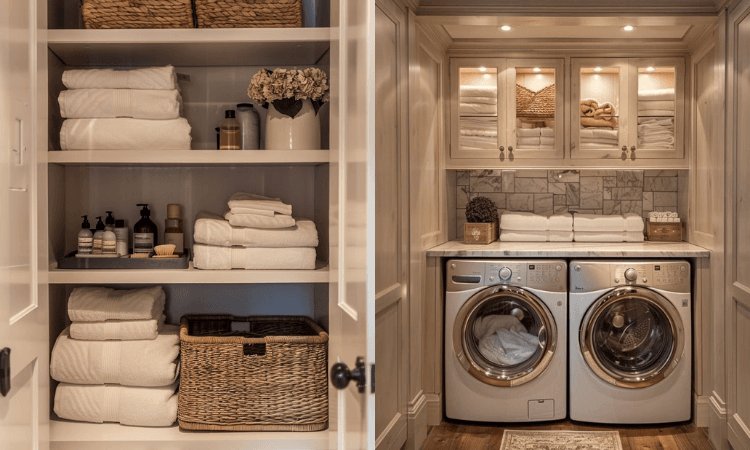A clutter-free home is not only visually appealing but also offers mental clarity and improved productivity. A clean, organized environment can reduce stress, help you focus, and make your home feel more spacious. However, keeping your home clutter-free can feel overwhelming, especially when clutter builds up over time. The good news is that maintaining a tidy home is achievable with the right approach and habits. This article provides practical tips and strategies to help you maintain a clutter-free home, ensuring your home remains a peaceful sanctuary.
Prioritize Decluttering High-Impact Areas
The first step in maintaining a clutter-free home is to focus on the areas that influence your daily life the most. By tackling high-traffic zones, you’ll feel a sense of relief and accomplishment. These spaces are often the most visible and used, so clearing them can make a significant difference.
Start with Frequently Used Spaces
Focus on areas like the kitchen, living room, and entryway. These spaces see the most action and can quickly become cluttered if not maintained. By starting here, you can make the biggest impact.
- Kitchen: The kitchen is the heart of the home, where meals are prepared and family members gather. Keeping countertops clear and organizing your pantry and cabinets will reduce the time you spend looking for ingredients or utensils, making the kitchen more functional.
- Living Room: The living room can easily become cluttered with magazines, toys, or extra cushions. Keeping this space tidy ensures it remains a relaxing environment.
- Entryway: The entryway is often the first area to become cluttered, so create a designated space for shoes and coats to immediately create a welcoming environment.
Decluttering these areas first ensures that you have a smooth, clutter-free experience in the parts of your home you use most. It provides a sense of accomplishment that motivates you to continue decluttering other areas.
Tackle Visible Clutter First
Visible clutter creates chaos and can make it hard to relax. When starting to declutter, focus on items that are out in the open, like those on countertops, tables, or floors. It’s often easier to make quick progress when you remove things you can see.
Sort items into “keep,” “donate,” and “discard” piles. This helps you make decisions about what you truly need and what should go. Once the visible clutter is gone, your space will feel instantly cleaner and more organized.
Set Achievable Goals
When decluttering, it’s important not to overwhelm yourself. Set small, achievable goals that you can complete in short bursts of time. Tackling one space at a time allows you to make steady progress without feeling like you’re trying to do everything at once.
- Tackle one room at a time, focusing on one area, like a countertop or a drawer, before moving on to the next.
- Set a timer for 15-30 minutes to avoid burnout and help you stay focused.
- Celebrate small victories—like clearing off an entire countertop—before moving on to other areas. Acknowledge your progress, and use it to keep up your momentum.
Organize with a Purpose

To maintain a clutter-free home, you need to think strategically about how you store and organize your belongings. Proper organization allows you to keep your home tidy with less effort, making it easier to maintain cleanliness over time.
Use every inch of available space effectively. Opt for multi-functional furniture, like ottomans with storage or beds with drawers underneath, which help to maximize space without sacrificing functionality. Additionally, take advantage of vertical storage solutions like shelves, hooks, or cabinets. This approach is especially useful in smaller spaces where floor space is limited. For items that are used infrequently, use storage bins or boxes that can be easily labeled and stacked for easy identification.
Storing similar items together makes it easier to locate them when needed and helps you avoid unnecessary clutter. For example, keep all your cleaning supplies in one area, and all your office supplies in another. Label everything you store so everyone in the household can easily find what they need and return things to their designated spots. To maintain a smooth organization system, apply the “one-in-one-out” rule: for every new item that enters your home, remove something that is no longer useful. This simple practice helps keep clutter from accumulating.
Build Habits for Long-Term Results
Maintaining a clutter-free home requires consistent habits that will help you keep things organized long after your initial decluttering. It’s important to change your approach to your daily routines and commit to keeping your home clean and tidy.
Set aside a few minutes each day to tidy up. Spend 10-15 minutes each day putting things away and organizing any messes that may have accumulated. It can be as simple as putting away clothes, wiping down surfaces, or placing shoes in their designated area. A small daily effort goes a long way in maintaining order. Additionally, tidy up before bed so you wake up to a fresh, clean space. This will help you start the day on the right foot, with a clear mind and a clutter-free environment.
Involve everyone in the household in maintaining the tidiness. Share the responsibility with family members and assign tasks to each person. Make the cleaning process more enjoyable by turning it into a game, or set challenges to see who can put away the most items in 10 minutes. Encourage everyone to keep their personal spaces organized as well. By fostering a team effort, keeping the home organized becomes a shared responsibility, making it much easier to maintain.
To stay on top of clutter, it’s helpful to regularly reassess your belongings. Periodically go through your items to determine if they are still needed or if they’ve simply become clutter. Consider doing seasonal decluttering, for example, during spring cleaning, where you can revisit your wardrobe, kitchen, and other areas. Ask yourself if each item still serves a purpose or if it’s just taking up space. Don’t hesitate to donate or discard anything you no longer need or use.
Reduce Future Clutter
The best way to maintain a clutter-free home is by preventing clutter from entering in the first place. While it’s important to regularly declutter, being mindful of how new items enter your home can drastically reduce clutter in the long term.
Before making any purchase, consider if it’s something you really need or if it will simply add to the clutter. Avoid impulse buys by waiting at least 24 hours before purchasing non-essential items. Stick to a shopping list when you go out and only buy what you’ve planned for. Mindful shopping helps prevent unnecessary items from entering your home, reducing future clutter.
Embrace a minimalist mindset by focusing on quality rather than quantity. Rather than collecting many similar items, invest in fewer but more useful things. For example, instead of buying multiple cheap items that don’t last, focus on purchasing high-quality products that will serve you for a longer time. This shift to minimalism can significantly reduce clutter in your home and lead to a more peaceful living space.
Sentimental items can also contribute to clutter, and they are often the hardest to part with. While it’s important to preserve memories, keeping every item with sentimental value can quickly become overwhelming. Be selective about what you keep. Store keepsakes in memory boxes or photo albums instead of allowing them to accumulate around the house. For digital memorabilia, take photos of items you’re ready to part with, so you can preserve the memory without the physical clutter.
Conclusion
Maintaining a clutter-free home doesn’t require perfection, just consistency. By following these tips—starting with high-impact areas, organizing with purpose, building good habits, and reducing future clutter—you can keep your home clean and peaceful. Remember, it’s an ongoing process. Start small, stay consistent, and enjoy the benefits of a clutter-free life.




